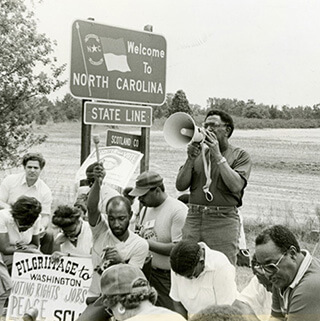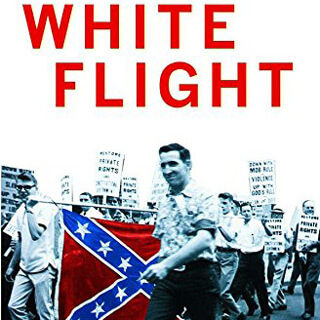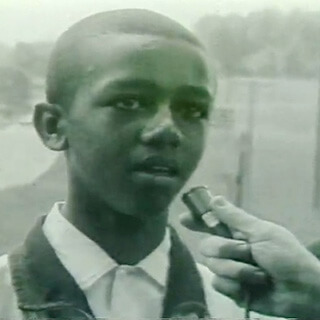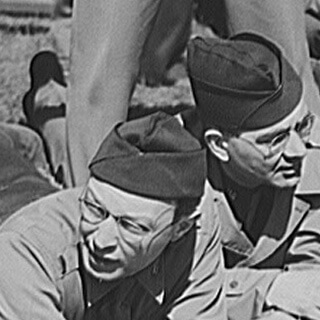Overview
Angela D. Dillard reviews Brett Gadsden's Between North and South: Delaware, Desegregation, and the Myth of American Sectionalism (Philadelphia: University of Pennsylvania Press, 2012).
Review
 |
I came to Brett Gadsden's work with some doubts of how and why the state of Delaware merited its own local study, and with growing apprehension about the proliferation of local studies within civil rights historiography in general. We are now some years past landmark publications such as Jeanne Theoharis and Komozi Woodard's Freedom North: Black Freedom Struggles Outside the South, 1940–1980 (2003), and even further beyond works such as John Dittmer's Local People: The Struggle for Civil Rights in Mississippi (1995).1Jeanne F. Theoharis and Komozi Woodard, eds., Freedom North: Black Freedom Struggles Outside the South, 1940–1980 (New York: Palgrave Macmillan, 2003); John Dittmer, Local People: The Struggle for Civil Rights in Mississippi (Urbana: University of Illinois Press, 1995). The most compelling of these studies demonstrate the extent to which attentiveness to one location allows us to understand the development of organizing networks on the ground and over a long period of time, typically measured in four to five decades or more. When they succeed, they open up new conceptual terrain in ways that encourage us to rethink some of our basic assumptions. I had not initially thought that Delaware could be rendered quite so emblematic and generative. I was wrong. The version of Delaware's history that emerges in these pages is ideally suited for the reevaluation of civil rights liberalism that Gadsden promotes.
Between North and South's focus on Delaware also allows for a critique of some facile assumptions about sectionalism in US history and politics. Conceptually, Gadsden is not breaking much new ground in this regard. Theoharis, Woodard, and the contributors to Freedom North urged a rethinking of traditional civil rights historiography rooted almost exclusively in southern states before the Watts riots, and Gadsden's focus on Delaware also stands alongside previous studies on border states, including Clarence Lang's Grassroots at the Gateway: Class Politics and Black Freedom Struggle in St. Louis, 1936–75 and Tracy E. K'Meyer's Civil Rights in the Gateway South: Louisville, Kentucky, 1945–1980.2Clarence Lang, Grassroots at the Gateway: Class Politics and Black Freedom Struggle in St. Louis, 1936–75 (Ann Arbor: University of Michigan Press, 2009); Tracy E. K'Meyer, Civil Rights in the Gateway South: Louisville, Kentucky, 1945–1980 (Lexington: University Press of Kentucky, 2009). But Gadsden is not merely replicating the work of others.
 |
| Michael Page, Percentage of Black Population in Newcastle County, Delaware in 1970, 2012. |
Indeed, I would suggest that the book's metropolitan focus is what places it at the cutting edge of contemporary scholarship in civil rights studies. Two aspects are key. He moves the narrative into the 1970s, and he adopts a metropolitan framework for which he provides an astute history, rooted in the postwar period. Here again the focus on Delaware serves him well, especially as he conjoins a metropolitan perspective that unites city and suburbs with the nuanced interplay of de facto and de jure segregation that sits at the very heart of his project.
Historians can, in some cases, be surprisingly inattentive to the inner workings of ideology. Gadsden avoids this pitfall, not only in his deft handling of different kinds of segregation as meaningful political, social, economic, and historical realities, but also in the distinctions between desegregation and integration (terms far too often used interchangeably). Because of his attention to people as agents and political actors, he is able to show how activists in the 1970s came to challenge the very distinctions between de jure and de facto segregation that those activists had insisted on and used so effectively in early decades. The goal of quality education for African American school children and an ethics of equity for all remained the same. What changed were matters of strategy, tactics, and language as the ground of the struggle was reconstituted in the wake of white flight and segregation in housing across the urban/suburban divide.
 |
| Louis R. Redding, left, of Wilmington, Del., and Thurgood Marshall, general counsel for NAACP, conferring at the Supreme Court during a recess in the court's hearing on racial integration in the public schools, Washington, DC, 1955. Library of Congress, Prints and Photographs Division, LC-USZ62-117797. |
Gadsden is quite fearless in his defense of civil rights liberalism. He knows that "radical" and "effective" are not necessarily synonymous, and he works to restore the connections between civil rights attorneys such as Louis Redding and the NAACP's Legal Defense Fund, on the one hand, and grassroots activism, on the other. As studies of the Black Power Movement have become prevalent, more moderate organizations such as the NAACP have been subject to a level of criticism that ignores their effectiveness and/or simply regards them as a foil for their more radical counterparts. Neither approach yields the sort of good, close, and even-handed history that Gadsden offers. One of Between North and South's central contentions is that civil rights liberals and proponents of school desegregation in Delaware possessed "a sophisticated understanding of the discursive and structural base of racial inequality" and forwarded a "dynamic, powerful, and efficacious challenge to these foundations," with tactics sensitive to changing patterns of racial segregation in the Jim Crow and post-Jim Crow eras. "The efforts of school desegregation proponents in this study," he concludes, "defy these neat categorizations and necessitate an appreciation of the organizational adaptability of civil rights organizations" (4).
This is the heart of this fine study. Less convincing, ultimately, is Gadsden's demonstration of the ways in which white backlash politics as "an equally sophisticated countermovement to school desegregation" (14) became a constitutive element of the black freedom struggle. He is right to see these opponents of reform as more than "simplistic reactionary adversaries" (17), and I applaud his attention to the details of the conservative ascendancy in the late 1960s and 1970s. As the narrative develops over the course of six chapters, however, we lose the sense of how the two movements—one in defense of desegregation and equal opportunity, the other in defense of white privilege and the status quo of discrimination and exclusion—become fully, mutually constitutive, especially enough to "expose a hidden narrative in school desegregation efforts and white backlash" (18).
Gadsden is spot-on in calling for more and better histories of conservative ascendency. And he is right that the issue of school desegregation efforts after the 1964 Civil Rights Act is a near perfect terrain for fully understanding the rifts in the old civil rights coalition between white liberals and black moderates, as well as the odd bedfellow moments between Black Power/Black nationalist advocates of community control of "ghetto schools" and white conservatives—not to mention the rise of a conservative ideology that claimed to act on behalf of civil rights and equal opportunity. The materials in chapter six on the interconnections between newly-elected freshman Senator Joe Biden and North Carolina's Senator Jesse Helms in debates over federally-mandated school desegregation in the North are especially instructive in this regard.
In sum, Between North and South is a deeply researched and powerfully argued account of school desegregation efforts and debates in Delaware. Gadsden asks the right questions in his pursuit of a broad-based analysis that links history with public policy and the study of US political culture in the second half of the twentieth century and beyond. His meditation on the paradoxes of de facto and de jure segregation and how they framed the efforts of civil rights liberals, political conservatives, and suburban whites bent on preserving the status quo of US racial formations is wonderfully illuminating and satisfyingly provocative. 
About the Author
Angela D. Dillard is a professor of social theory and practice at the University of Michigan where she specializes in American and African-American intellectual history, particularly around issues of race, religion, and politics. She is the author of Guess Who’s Coming to Dinner Now?: Multicultural Conservatism in America (New York University Press, 2001) and Faith in the City: Preaching Radical Social Change in Detroit (University of Michigan Press, 2007). Professor Dillard is currently at work on a political biography of James H. Meredith.
Recommended Resources
Dittmer, John. Local People: The Struggle for Civil Rights in Mississippi. Urbana: University of Illinois Press, 1995.
Joseph, Peniel. Waiting 'til the Midnight Hour: A Narrative History of Black Power in America. New York: Henry Holt and Co., 2006.
K'Meyer, Tracy Elaine. Civil Rights in the Gateway to the South: Louisville, Kentucky, 1945–1980. Lexington: University Press of Kentucky, 2009.
Lang, Clarence. Grassroots at the Gateway: Class Politics and Black Freedom Struggle in St. Louis, 1936–75. Ann Arbor: University of Michigan Press, 2009.
Sugrue, Thomas. Sweet Land of Liberty: The Forgotten Struggle for Civil Rights in the North. New York: Random House, 2008.
Woodard, Komozi and Jeanne Theoharis. Freedom North: Black Freedom Struggles Outside the South, 1940–1980. New York: Palgrave Macmillan, 2003.
Links
National Association for the Advancement of Colored People, Official Website
http://www.naacp.org/.
"Delaware: Conflict in a Border State," Separate Is Not Equal: Brown v. Board of Education, Smithsonian National Museum of American History
http://americanhistory.si.edu/brown/history/4-five/delaware-1.html.
Similar Publications
| 1. | Jeanne F. Theoharis and Komozi Woodard, eds., Freedom North: Black Freedom Struggles Outside the South, 1940–1980 (New York: Palgrave Macmillan, 2003); John Dittmer, Local People: The Struggle for Civil Rights in Mississippi (Urbana: University of Illinois Press, 1995). |
|---|---|
| 2. | Clarence Lang, Grassroots at the Gateway: Class Politics and Black Freedom Struggle in St. Louis, 1936–75 (Ann Arbor: University of Michigan Press, 2009); Tracy E. K'Meyer, Civil Rights in the Gateway South: Louisville, Kentucky, 1945–1980 (Lexington: University Press of Kentucky, 2009). |





